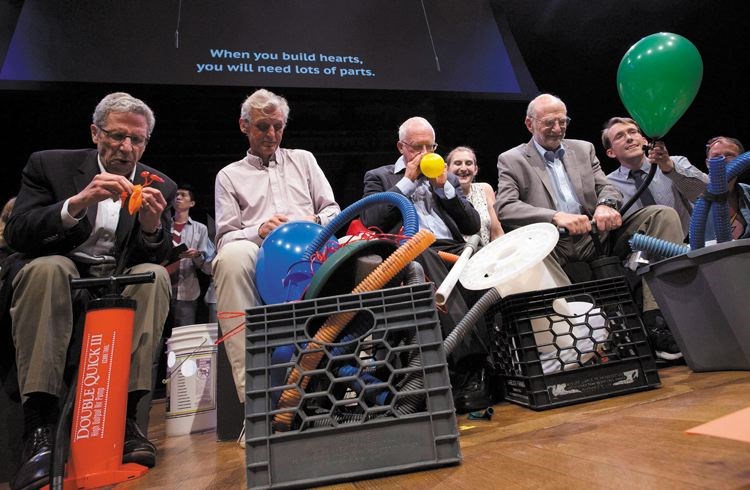Early in October each year the Nobel Prize committees release the names of the honorees in Medicine and Physiology, Chemistry, Physics, Literature, and Economics. Winning a Nobel Prize is a singular mark of distinction. It is the crowning glory for a career spent on the cutting edge of science.
In early September, the editors of the Annals of Improbable Research host a slightly less solemn affair, the Ig Noble Prizes, honoring "achievements that first make people laugh, and then make them think."
It is a good bit of fun held each year at Harvard University with Nobel Laureates as presenters and some amazing science demos entertaining the audience.
The research performed by the honorees is serious work published in peer-reviewed journals although these papers are the sort which causes people to roll their eyes and politicians to complain about research funding. But they do have scientific merit and can often lead to much more interesting research.
In 2018, there were a number of awards handed out as they do not restrict the awards to the five Nobel Prize categories.
For medicine, the award went to Marc Mitchell and David Wartinger for their work showing how a roller coaster ride could be used to hasten the passage of kidney stones. Kidney stones account for approximately 300,000 emergency room visits in North America every year as passing a stone is a long and painful process.
Anything which can speed the passage seemed reasonable so when the authors heard anecdotal evidence to suggest riding a roller coaster helps to speed the process, they decided to investigate.
While it might seem somewhat frivolous, their work stands up to scientific rigour and more importantly the rear seat of a roller coaster might just ease someone's pain.
For anthropology, the award was given to Tomas Persson, Gabriela-Alina Sauciuc and Elaine Madsen for demonstrating chimpanzees at a zoo imitate humans about as often as the humans imitate chimpanzees.
Imitation is a critical component of our education albeit a mostly unconscious one.
We imitate family members and others to learn visual clues and behavioural responses. The authors were able to show this is not a uniquely human trait and crosses inter-species boundaries. As imitation is the sincerest form of flattery, next time you visit a zoo chimpanzees might be flattering you.
For chemistry, the award was earned by Paula Romao, Adilia Alarcao and Cesar Viana for studying what every mother knows - saliva is an effective cleaning agent. The inspiration behind their work is a common practice by museum conservationists who will often use their own saliva to clean delicate gilded surfaces such as gold leaf. The enzymes in saliva are particularly effective at breaking down the biological components in smudges.
For literature, the award was given to Thea Blackler, Rafael Gomex, Vesna Popovic, and M. Helen Thompson for documenting the fact most people do not read instruction manuals. This is despite the best efforts of technical writers and graphic designers. We simply don't want to spend the time preferring to figure the device out ourselves. Understanding this might help produce better manuals, but most likely we still won't read them.
For nutrition, the award went to James Cole for determining the relative nutritional benefits of a traditional meat-based diet versus human-cannibalism.
It turns out, humans are not particularly nutritious when compared to other forms of meat plus there are all the parasites and potential diseases within human flesh.
This coincides with the theory human-cannibalism was more about capturing a person's spirit or physical properties than maintaining a good steady diet.
For peace, the award was presented to Francisco Alonso and co-authors for analyzing something almost all of us do: cursing and shouting while driving an automobile. By studying the frequency, motivation and effects of outbursts, the authors were able to show aggression behind the wheel is not simply about letting off some steam. It has the opposite effect of leading to road rage and a high level of aggression is associated with higher accident rates worldwide.
On the other hand, the award for economics was given to Lindie Hanyu Liang and co-authors for investigating the effectiveness of voodoo dolls as a method for employees to retaliate against abusive bosses. If you have a supervisor who routinely engages in behaviour such as scapegoating, public ridicule, belittling or other such abuse, it is likely you will want to retaliate to restore a sense of justice in the work place. This can escalate the situation leading to a poisoned workplace.
Instead, stabbing a voodoo doll with pins can be much more cathartic and alleviate the tension. It is one way to possibly right the balance of feeling wronged and could lead to other non-confrontational strategies for dealing with work place problems.
Voodoo dolls of bosses and a spit shines - science which first makes you laugh and then makes you think.



